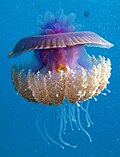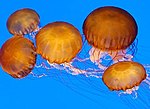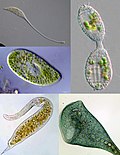strobilation. This latter process occurs during the colonial polyp stage and produces either polyps or juvenile Medusae called ephyra. Strobilation tend...
4 KB (438 words) - 17:47, 11 September 2024
onto another. Fragmentation (reproduction) Paratomy Fission (biology) Strobilation James Desmond Smyth, Derek Wakelin (1994). Introduction to animal parasitology...
4 KB (432 words) - 15:12, 7 May 2024
medusae that pinch off and swim away in a process known as strobilation. Once strobilation is complete, the polyp may die, or regenerate itself to repeat...
13 KB (1,728 words) - 18:13, 28 September 2024
allow for a longer strobilation period and subsequently higher ephyra production per polyp, higher percentages of polyp strobilation, and higher polyp...
15 KB (1,517 words) - 21:17, 8 August 2024
complex structures takes place completely within the stages of adult strobilation and not during gastrulation. In most schyphozoa and cubozoa, sessile...
13 KB (1,614 words) - 18:38, 6 April 2024
budding several medusae off from its upper surface via a process called strobilation. The medusae are initially microscopic and may take years to reach sexual...
10 KB (1,152 words) - 01:08, 9 August 2024
by strobilation or sexually. Either ephyrae or planuloids may be produced by strobilation; only ephyrae can produce the medusal form. Strobilation can...
3 KB (323 words) - 18:16, 27 February 2023
into a special type of polyp called a "scyphistoma", which divides by strobilation into small ephyrae that swim off to grow up as medusae. There is an increasing...
19 KB (2,044 words) - 04:48, 7 October 2024
for syphistomae strobilation, the medusae disappear in Clear Lake. The medusa population is reestablished by syphistomae strobilation when conditions...
25 KB (2,890 words) - 02:32, 10 October 2024
repeatedly bud medusae from their upper surface in a process known as strobilation. Cubozoa is a group commonly known as box jellyfish, that occur in tropical...
13 KB (1,176 words) - 20:03, 10 August 2024
attached stauromedusa. Unlike most scyphozoan jellyfish that practice strobilation, or the process of dividing themselves into body segments, which become...
5 KB (403 words) - 04:23, 11 March 2024
into a series of disks that become juvenile medusae, a process called strobilation. The juveniles swim off and slowly grow to maturity, while the polyp...
81 KB (8,949 words) - 14:25, 15 October 2024
(above the mouth), or the gonads of hydromedusae. In a process known as strobilation, the polyp's tentacles are reabsorbed and the body starts to narrow,...
119 KB (12,443 words) - 05:00, 5 October 2024
consume prey with these tentacles. Polyps perform the essential process of strobilation, a type of asexual reproduction. Polyps may develop directly into medusa...
12 KB (1,349 words) - 13:51, 15 January 2024
produces a chain of segments called proglottids via a process known as strobilation. As a result, the most mature proglottids are furthest from the scolex...
64 KB (6,636 words) - 23:38, 16 October 2024
ciliated offspring, or "swarmers", from the body of a mature parent); strobilation (multiple divisions along the cell body, producing a chain of new organisms);...
33 KB (3,421 words) - 16:09, 20 October 2024
put in their own class due to their unique biological cycle (lack of strobilation) and morphology. At least 51 species of box jellyfish were known as of...
50 KB (5,588 words) - 21:53, 19 October 2024
occurs via side budding, one bud per polyp, and strobilating. During strobilation, the polyp is lengthened and thinned while tentacles are shortened and...
17 KB (2,229 words) - 16:23, 19 October 2024
oozooid acquires sufficient size it undergoes a form of cloning called strobilation during which its body is pinched into 2 to 6 buds (also known as strobilae)...
10 KB (1,305 words) - 20:46, 15 September 2024
develop into their polyp stage. The polyp reproduces asexually through strobilation which produces an Ephyra, a juvenile stage that matures into the medusa...
16 KB (1,706 words) - 16:39, 26 August 2024
continuously differentiated near the anterior end in a process called strobilation. Each segment moves toward the posterior end as a new one takes its place...
14 KB (1,774 words) - 01:08, 18 September 2024
turns into polyp then attach to substrates for up to half a year till strobilation. Under warm condition, the polyps will reproduce asexually, under cold...
8 KB (932 words) - 00:46, 14 June 2024
occurrence at such deep depths, but they are known to reproduce asexually. Strobilation can be induced by a period of low temperatures, and they strobilate throughout...
9 KB (937 words) - 04:16, 9 December 2023
Holst, S.; Jarms, G. (2010). "Effects of low salinity on settlement and strobilation of scyphozoa (Cnidaria): Is the lion's mane Cyanea capillata (L.) able...
11 KB (1,241 words) - 07:25, 3 May 2024
results in a regenerative remnant. This medusa form is thought to be from strobilation known from scyphozoa. The results of this study show that nearly 45%...
19 KB (2,407 words) - 21:00, 15 September 2024
fossils as representing a basal disk and lappets corresponding to the strobilation stage of modern scyphozoans. This hypothesis was later criticized, as...
5 KB (465 words) - 22:37, 4 June 2024
responsible for the continual production of new organs during the process of strobilation (segment formation). Neoblasts divide in the neck region and become incorporated...
10 KB (1,137 words) - 23:29, 19 October 2024
point, if conditions are favorable, they will undergo a process known as strobilation. This is when the polyp asexually produces the ephyrae into the water...
6 KB (681 words) - 14:39, 3 December 2023
egg becomes a polyp which is produced through the process of budding (strobilation). The polyp like stage (known as a scyphistoma) of development starts...
10 KB (1,129 words) - 20:12, 15 March 2024
cubozoan polyp develops into a medusae, as opposed to going through strobilation. The habitat of Chiropsella bronzie polyps is still unknown, but research...
13 KB (1,572 words) - 13:03, 17 March 2023



























